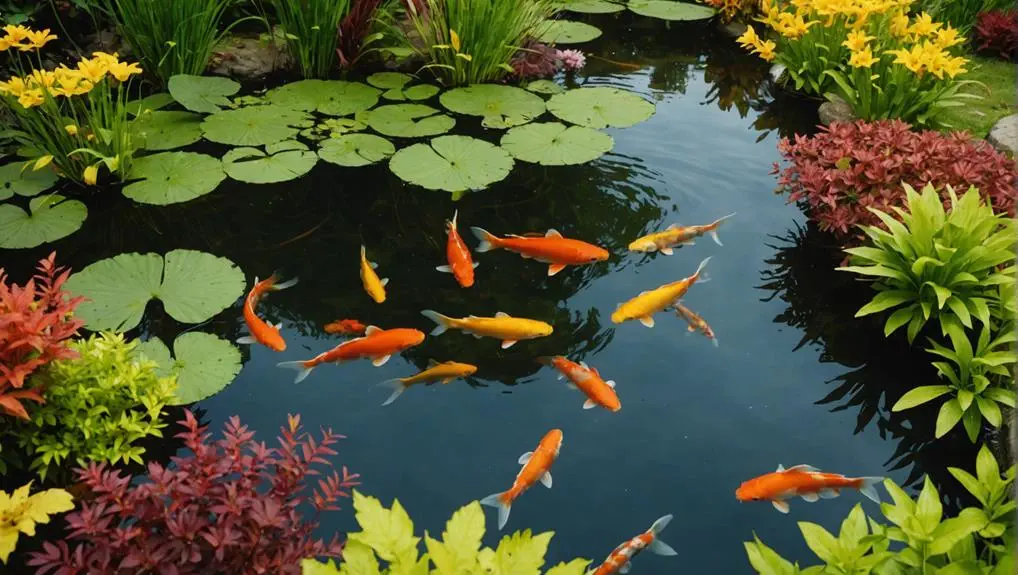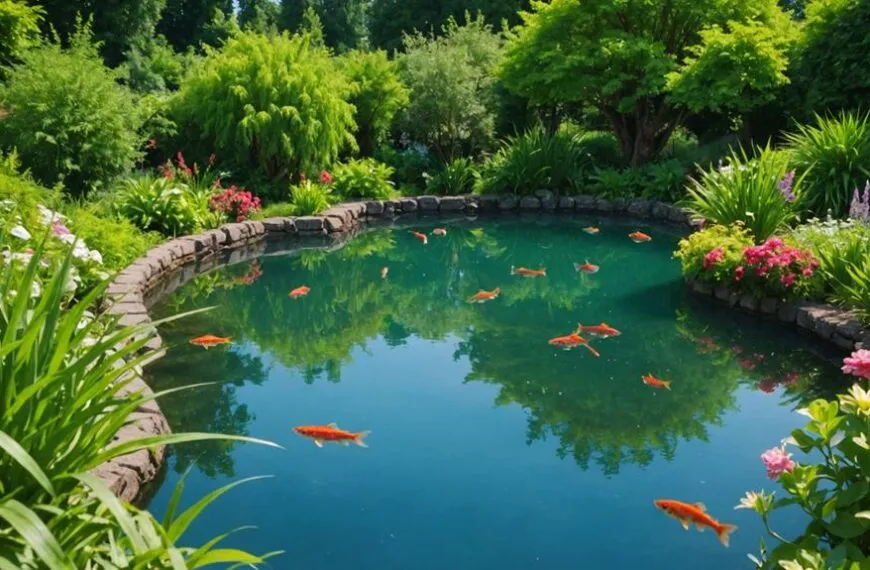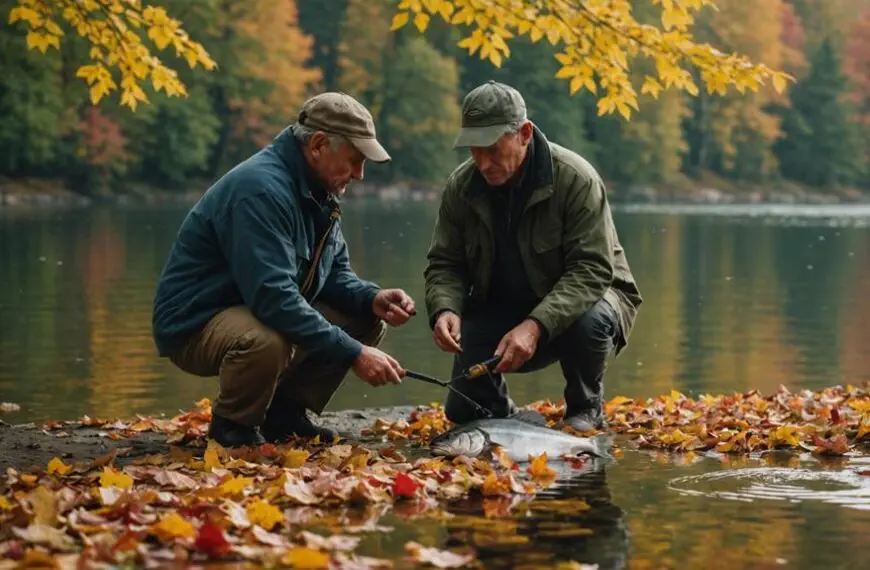Caring for your pond fish season by season is crucial for their happiness and health. In winter, ensure your pond's deep enough for them to hibernate safely, and stop feeding when the water's below 50°F. Spring means cleaning out debris and testing water quality, while summer requires you to monitor temperatures and keep that feeding moderate. As autumn arrives, focus on keeping oxygen levels stable and clear the way for winter. Don't forget about tropical fish; they might need some extra indoor TLC. Stick around, and you'll discover more tips to keep your aquatic friends thriving all year!
Contents
Winter Care Essentials
When winter rolls in, ensuring your fish stay healthy is crucial. To give them the best chance during the frozen months of winter, check your pond depth. Ideally, it should be at least 2 feet deep, allowing your fish enough space to hibernate while withstanding winter temperatures. Remember, frost can penetrate up to 8 inches, so depth matters!
As the water temperatures drop, stop feeding your fish once they fall below 50°F. Their digestive systems slow down, and overfeeding can lead to health issues.
It's also vital to monitor ice thickness regularly. Keep part of the pond open using aerators or de-icers, which help with gas exchange and prevent toxic buildup.
If you have tropical fish, consider relocating them indoors. They simply can't handle the chill of outdoor pond temperatures.
Keeping your pond equipment, like aerators and pumps, in good shape is essential, too. Make sure to check them regularly to avoid any failures that could jeopardize your fish's health.
With these winter care essentials, you can create a cozy environment for your aquatic friends, even when the weather outside is frightful!
Spring Pond Preparation
As temperatures begin to rise and nature awakens, it's time to prepare your pond for spring. Start by inspecting your pond's water feature for any cracks or clogs. You want everything running smoothly as the weather warms up!
Cleaning is essential, so thoroughly scrub the pump and filter to remove any debris or organic waste that piled up over winter. This will help boost your water quality and keep your fish healthy.
Don't forget to leave the aerator in the pond. It'll maintain oxygenation, which is crucial for your fish's well-being.
While you're at it, give your pond a good spring cleaning. Remove leaves, branches, and sludge, but be gentle with beneficial bacteria that support your pond's ecosystem.
Lastly, test the water for ammonia and nitrite levels. If they're too high, perform some partial water changes to create a safe environment for your fish.
Summer Maintenance Tips
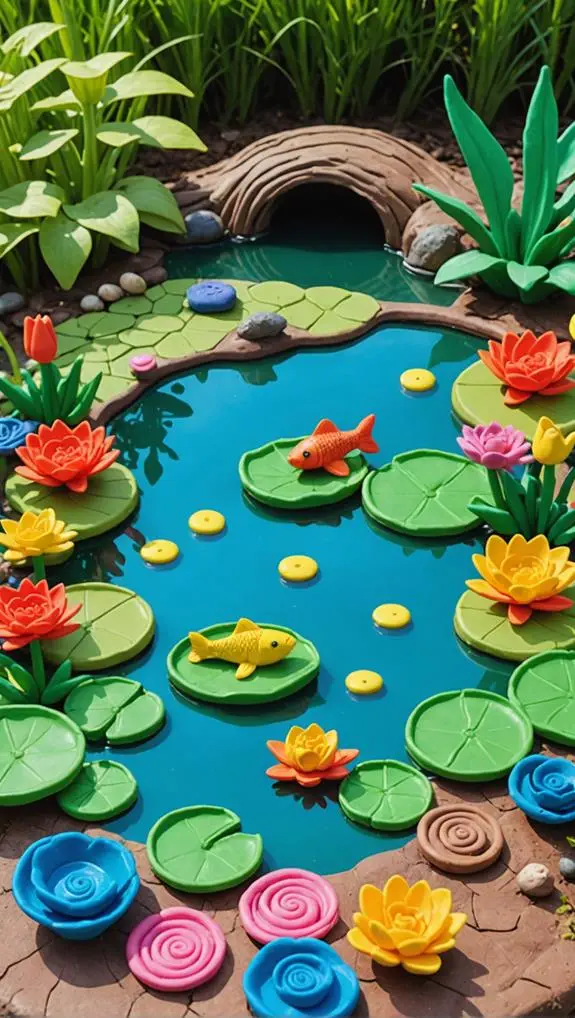
With summer in full swing, keeping your pond healthy is essential for your fish's well-being. Start by monitoring water temperatures; if they rise above 85°F, it can lead to reduced dissolved oxygen, stressing your fish health. You wouldn't want your fish to feel like they're in a sauna!
Regular testing of ammonia and nitrate levels can help ensure that your pond remains a safe environment for your fish, as water quality importance is crucial for their health.
Feed your fish just once a day, offering them a portion they can devour in 3-5 minutes. This helps prevent overfeeding, which can cloud your water quality and lead to algae growth.
Speaking of algae, regularly remove any dead organic matter from the pond to maintain a clean ecosystem.
Don't forget about aeration! Use aerators, waterfalls, or fountains to keep those oxygen levels up. Your fish will appreciate the extra oxygen, especially in the heat.
And let's not overlook your aquatic plants! Fertilize them when the water hits 72°F, and don't hesitate to prune or reposition them when needed. This keeps everything in balanced growth, ensuring a vibrant underwater habitat.
With these simple tips, you can create a thriving summer oasis for your fish and enjoy the beauty of your pond even more!
Fall Transition Strategies
As the leaves start to fall and the air gets crisp, it's time to give your pond some extra love for the upcoming winter months.
Keeping the water oxygenated, clearing out debris, and ensuring your equipment is ready to go will make a big difference for your fish.
Trust me, a little fall prep now means a smoother ride through the chilly season ahead!
Aeration Maintenance Importance
Maintaining proper aeration during the fall transition is vital for your fish's health. As temperatures drop, it's crucial to ensure that your aeration system keeps the oxygen levels in the pond stable. This helps your fish acclimate to the cooler conditions, preparing them for winter. An operational aerator will circulate the warmer water from the bottom to the surface, creating a comfortable environment for your fish.
It's important to monitor your aerator equipment regularly during this time. A malfunction could lead to low oxygen levels, which can cause stress and illness in your fish. Remember, as temperatures fall below 60°F, your fish's metabolism slows down, making them more vulnerable.
Carefully consider where you place your aerators. Positioning them at the surface not only promotes gas exchange but also prevents ice formation, which can create toxic conditions for your fish.
Keeping an eye on these systems will help you maintain a safe and healthy pond environment. So, grab that checklist and get ready to ensure your fish are cozy and thriving this fall! After all, happy fish make for a happy pond!
Debris Removal Techniques
Keeping your pond clean is just as important as ensuring proper aeration. As fall rolls in, it's time to tackle debris removal. Start by grabbing a pond net or rake to collect leaves, twigs, and other organic matter. If you let them sink, they'll decompose, harming your water quality.
You might even want to partially drain the pond for a thorough cleaning, removing sludge from the bottom to prevent toxic build-up.
Using a skimmer or leaf blower can make your life easier, allowing for efficient debris removal while keeping the ecosystem undisturbed. Don't forget to trim back those overgrown aquatic plants! This simple step reduces nutrient load and improves water circulation, which can prevent those pesky algae blooms come spring.
Lastly, keep a close eye on your filtration system. Clogged filters can wreak havoc on your pond care efforts by diminishing water clarity and quality. Regular maintenance is key.
Equipment Winterization Steps
Prepare your pond equipment for winter by taking proactive steps before temperatures dip below 50°F. Keeping your pond ready for the winter months is crucial for your fish's well-being. Here's how to ensure everything stays in tip-top shape:
- Clean and Store: Remove any movable equipment like pumps and filters. This prevents freeze damage and corrosion, keeping everything working smoothly come spring.
- Drain Hoses and Pumps: Disconnect and drain all hoses and pumps. Water expansion can crack your equipment, and we don't want that!
- Trim Aquatic Plants: Trim back your plants and remove debris. This reduces waste accumulation and helps keep your pond healthy for your fish.
- Monitor Ice Formation: Keep an eye on ice formation and maintain channels of open water. This is vital for gas exchange, as fish need oxygen to survive.
Don't forget to insulate your pond with thermal covers! It helps maintain stable water temperatures and protects those beneficial bacteria.
Tropical Fish Considerations
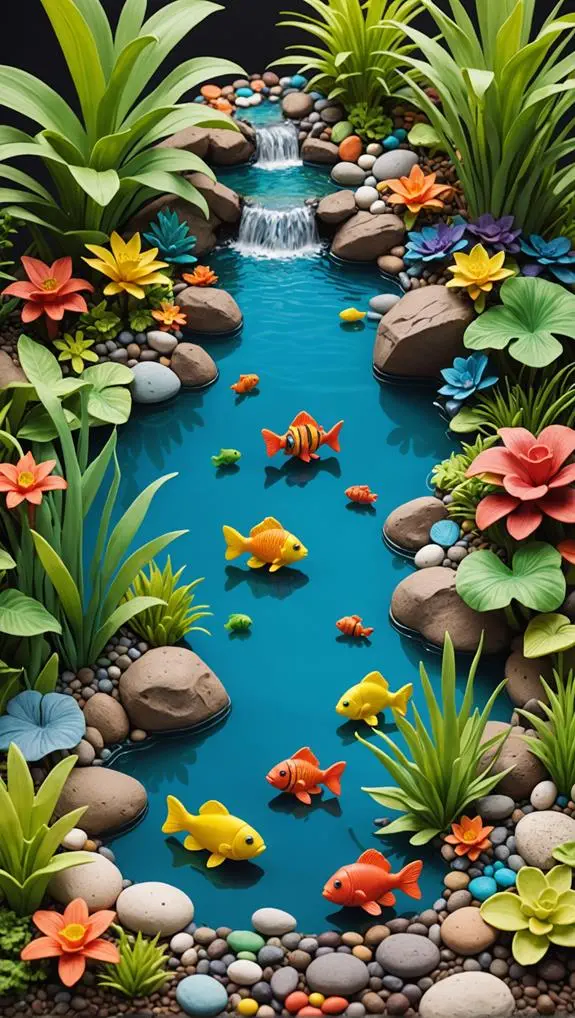
When it comes to tropical fish, keeping their environment just right is key to their happiness and health.
You'll want to aim for that sweet spot of 75-80°F, and remember that not all fish get along, so pay attention to their compatibility.
Maintaining optimal water quality parameters, such as pH and ammonia levels, is essential for their well-being, as indicated by water quality parameters.
With the right care, including good filtration and regular checks, your vibrant underwater friends can thrive in your pond like they're on a tropical vacation!
Ideal Temperature Range
For tropical fish, maintaining a stable water temperature is crucial to their health and well-being. These colorful aquatic friends thrive best in outdoor ponds with a water temperature between 75°F and 80°F.
If you want to keep them happy, consider these important points:
- Sensitive Nature: Tropical fish are more sensitive to cooler conditions than temperate fish.
- Temperature Drops: A sudden dip below 65°F can shock them, impacting their immune function.
- Consistent Monitoring: Regularly check the water temperature to avoid harmful fluctuations.
- Acclimation Needs: Bring them indoors when nighttime temperatures consistently drop below 75°F.
To ensure your tropical fish stay within their ideal temperature range, you might need to invest in heaters or look into insulated setups.
Remember, their comfort is your responsibility! By keeping a watchful eye on water temperature and being proactive about acclimation, you can help your fish thrive. It's not just about keeping them alive; it's about creating a vibrant, joyful environment where they can flourish.
Species Compatibility Issues
Navigating species compatibility in tropical fish can be a complex task, as not all fish get along well together. When you're choosing tropical fish for your outdoor pond, it's essential to consider their compatibility. Some species, like certain cichlids, can be quite aggressive, making it crucial to research their behavior before mixing them with others.
You'll also want to pay attention to your local climate. Not all tropical fish can handle temperature variance, especially during seasonal transitions. Some might thrive, while others could struggle or even perish in cooler conditions.
Understanding the social dynamics of your fish is key. Compatible species will swim happily together, while incompatible ones may spark territorial disputes, leading to stress.
A varied diet, including insects and algae, can help keep your fish healthy and happy. Just be cautious about overstocking your pond; too many fish can lead to competition for food, which often results in aggressive behavior.
Habitat Requirements and Care
Creating a thriving habitat for tropical fish requires careful attention to their specific needs. To ensure your fish are happy and healthy, keep these habitat requirements in mind:
- Water Temperature: Aim for a warm and stable temperature above 70°F. Tropical fish love warmth—think of it as their vacation spot!
- Pond Depth: Maintain at least 2 feet of pond depth. This gives your fish a cozy winter retreat where they can find warmer spots.
- Water Quality: Regularly test your water for pH, ammonia, and nitrates. Remember, tropical fish are sensitive; think of them as the divas of the pond world!
- Aquatic Plants: Incorporate lush aquatic plants. They not only beautify your pond but also provide shade and hiding spots, reducing stress for your fish.
Don't forget that choosing compatible species is crucial for your pond's harmony.
Research each fish's needs to prevent any squabbles.
With seasonal care and attention to these key factors, your outdoor pond can become a delightful oasis for your tropical fish, bringing joy to both you and your finned friends!
Water Quality Management
Maintaining optimal water quality is essential for a thriving pond ecosystem and the health of your fish. You want your aquatic friends to flourish, right? Regular water testing for pH, ammonia, nitrites, and nitrates is a must. Aim for a pH between 6.5 and 8.5 and keep ammonia levels at 0 ppm to ensure your fish are swimming happily.
Be aware that ammonia spikes can be harmful to fish, often resulting from overfeeding and waste buildup, so monitoring these levels is crucial for their well-being effective management strategies.
Don't forget about partial water changes! Changing 10-20% of the water weekly helps dilute harmful substances and keeps everything stable. Think of it like a refreshing spa day for your pond!
High carbonate hardness (KH) is also important, so keep that above 80 mg/L to buffer against pH fluctuations.
Incorporating aquatic plants into your pond can be a game changer. They not only add beauty but also produce oxygen, absorb excess nutrients, and provide homes for beneficial bacteria.
It's like giving your pond a little community to thrive in! By managing water quality, you're not just serving your fish; you're creating a vibrant ecosystem that everyone can enjoy.
Common Pond Challenges
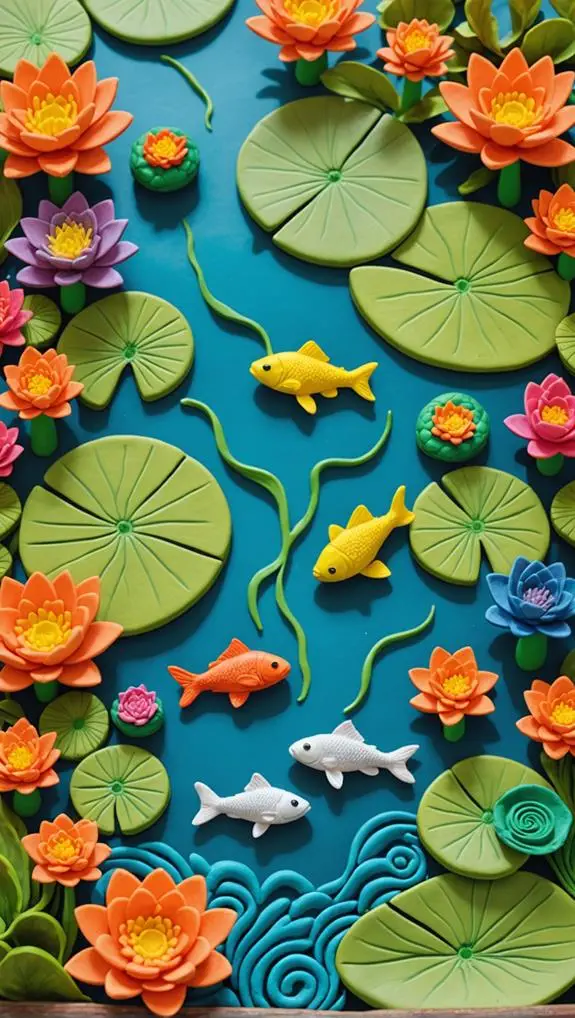
Despite your best efforts in water quality management, common pond challenges can still arise, especially as seasons change.
Keeping a close eye on your pond is essential. You've got to watch for shifts in fish behavior and water conditions that can affect your aquatic friends' health.
Here are some challenges you might encounter:
- Algae growth: That green stuff can be a real nuisance, often signaling nutrient imbalances.
- Local predators: Birds and raccoons can turn your serene pond into a buffet. Netting is your friend!
- Overfeeding: It's tempting to spoil your fish, but too much food can lead to poor water quality. They're not picky eaters; they'll be fine.
- Sludge buildup: Seasonal cleaning is crucial. Removing debris helps maintain a healthy pond ecosystem.
Regular routine maintenance is key to keeping your pond's aquatic environment thriving.
By tackling these challenges, you're not just doing chores; you're creating a safe haven for your fish.
Frequently Asked Questions
How to Keep Fish Alive in a Pond During Winter?
To keep fish alive during winter, monitor water temperature, stop fish feeding below 50°F, maintain oxygen levels, manage ice formation, provide winter shelter, and control algae for optimal fish behavior and health.
Can You Leave Fish in a Pond Over Winter?
While you can leave fish in a pond over winter, consider pond temperature and depth. Ensure oxygen levels remain stable, manage ice formation, and provide hiding spots. Skip winter feeding to maintain water quality for sensitive species.
Should I Bring My Pond Fish in for the Winter?
You should consider bringing your pond fish in for winter, especially sensitive species. Monitor water temperature and oxygen levels, ensure proper pond insulation, and manage ice to protect their health during this critical season.
How Do You Prepare a Fish Pond for Winter?
To prepare your pond for winter, follow these pond winterization tips: remove debris, insulate edges, install heaters, ensure sufficient aeration, create windbreak barriers, and monitor fish behavior to maintain water quality during colder months.
Final Thoughts
Taking care of your outdoor pond throughout the seasons is no small task, but it's totally worth it! Did you know that fish can live up to 200 years in the right conditions? That's a long time to enjoy their company! By following these seasonal tips, you can create a thriving environment for your fish, keeping them healthy and happy. So, roll up your sleeves, dive in, and make your pond the best it can be—your fish will thank you!

